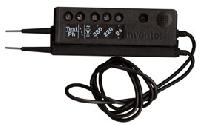Voltage indicators
Voltage indicators are portable devices designed to check the presence or absence of voltage on live parts. Such a check is necessary, for example, when working directly on disconnected live parts, when monitoring the health of electrical installations, finding faults in an electrical installation, checking an electrical circuit, etc.
In all these cases, only the presence or absence of voltage is required to be established, but not its value, which is usually known.
 All indicators have a light signal, the illumination of which indicates the presence of voltage on the tested part or between the tested parts. References are available for electrical installations up to 1000 V and higher.
All indicators have a light signal, the illumination of which indicates the presence of voltage on the tested part or between the tested parts. References are available for electrical installations up to 1000 V and higher.
Indicators intended for electrical installations up to 1000 V are divided into two-pole and one-pole.
Bipolar indicators require touching two parts of the electrical installation, between which it is necessary to determine the presence or absence of voltage.Their principle of operation is the glow of a neon or incandescent lamp (not more than 10 W) when a current flows through it due to the potential difference between the two parts of the electrical installation to which the index finger touches. Consuming low current — from fractions to several milliamps, the lamp provides a stable and clear light signal, emitting an orange-red light.
After the discharge occurs, the current in the lamp circuit gradually increases, i.e. the resistance of the lamp appears to decrease, eventually causing the lamp to fail. To limit the current to a normal value, a resistor is connected in series with the lamp.

Bipolar indicators can be used in both AC and DC installations. With alternating current, however, the metal parts of the pointer—the lamp base, the wire, the probe—can create a capacitance to ground or other phases of the electrical installation sufficient so that when only one probe touches the phase, the neon lamp pointer lights up. To eliminate this phenomenon, the circuit is supplemented with a shunt resistor that turns off the neon lamp and has a resistance equal to the additional resistor.
 Single-pole indicators require touching only one live part under test. The connection to the ground is provided through the human body making contact with the index finger. In this case, the current does not exceed 0.3 mA.
Single-pole indicators require touching only one live part under test. The connection to the ground is provided through the human body making contact with the index finger. In this case, the current does not exceed 0.3 mA.
Single-pole indicators are usually made in the form of an automatic pen, in the case of which, made of insulating material and with an inspection hole, there is a signal lamp and a resistor; on the lower end of the body is a metal probe, and on the upper end is a flat metal contact that the operator touches with a finger.
The single-pole indicator can only be used in AC installations, because with direct current its lamp does not light even when voltage is present. It is recommended for use in checking secondary switching circuits, determining the phase wire in electrical meters, lamp holders, switches, fuses, etc.
When using voltage indicators up to 1000 V, you can do without safety devices.
Safety regulations prohibit the use of the so-called test lamp instead of a voltage indicator - a lamp with an incandescent filament screwed into a socket loaded with two short wires. This prohibition is due to the fact that if the lamp is accidentally turned on at a voltage higher than calculated, or if it hits a hard object, its bulb may burst and the operator may be injured as a result.
Indicators for electrical installations with a voltage of more than 1000 V, also called high voltage indicators (HVD), work on the principle of the glow of a neon lamp when a capacitive current flows through it, i.e. charging current of a capacitor connected in series with a light bulb. These pointers are only suitable for AC installations and should only be approached on one phase.
The design of the indicators is different, but the UVN always has three main parts: working, consisting of a housing, signal lamp, capacitor, etc., insulating, which provides isolation of the operator from live parts and made of insulating materials, a handle, designed to hold the indicator.
 Dielectric gloves should be used when using UVN.Each time before using the UVN, it is necessary to inspect it externally to ensure that there is no external damage and to check the correctness of its operation, i.e. ability to signal.
Dielectric gloves should be used when using UVN.Each time before using the UVN, it is necessary to inspect it externally to ensure that there is no external damage and to check the correctness of its operation, i.e. ability to signal.
Such a check is carried out by bringing the pointer probe closer to live parts of the electrical installation that are obviously live. It can be checked for serviceability and using special high voltage sources, as well as using a megohmmeter and finally by bringing the pointer probe closer to the spark plug of a running car or motorcycle.
It is forbidden to ground the pointers, because even without grounding, they provide a clear enough signal, in addition, the grounding wire can cause an accident by touching live parts.
In some situations where the capacitance of the pointer to grounded objects is very small (for example, when working on wooden poles of overhead power lines), the voltage pointer must be grounded.
